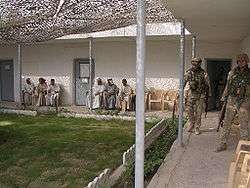Civil-military operations center
A civil-military operations center or CMOC is a center usually established by a military force for coordinating civil-military operations in an area of operations.[1][2] This center usually serves as a meeting place for military and non-military entities involved in governance, stabilization, humanitarian relief and reconstruction activities or for interaction between the entities involved in these activities and the civilian population. Often, it also serves as a central location for information on civilian related activities in the area or maintains the status of the infrastructure or institutions. During combat operations, a CMOC is usually in a secure compound.
Temporary governance
A civil-military operations center can be used as a place for temporary governance until the normal civilian governance is reestablished in an area impacted by military operations or natural or man-made disaster. In a military operations, temporary governance is often referred to as military governance, and is often performed by military organizations until the normal governmental body can perform these duties. This allows for the functions of governance to continue during a crisis situation.
International operations
Humanitarian operations involving multiple international organizations often use other terms for a CMOC, such as combined coordination center. These centers seek to achieve coordination and unity of effort among organizations delivering humanitarian aid during disaster relief.
Historical examples
Iraq War
During the Iraq War, the U.S. Marines operated a CMOC near the city of Fallujah outside of the MEK Compound.[3] This CMOC was called the Fallujah Liaison Team or F.L.T. and it was a compound used for interaction between the Marines and the local civilians. At the F.L.T., Marines supported by U.S. Navy Seabees developed and managed reconstruction projects with local contractors. Marines also settled battle damage claims and facilitated reestablishment of local governance.
2004 Indian Ocean earthquake
During the humanitarian response to the 2004 Indian Ocean earthquake, militaries from multiple countries worked with non-governmental organizations at a Combined Coordination Center to organize delivery of humanitarian aid to the region.[4]
Notes
- Chairman, U.S. Joint Chiefs of Staff. Civil-Military Operations, Joint Publication (JP) 3-57 (Washington, DC: CJCS, July 08, 2008), p. xviii.
- Office of Military Affairs, U.S. Agency for International Development. Civilian-Military Operations Guide (April 27, 2010), p. 34.
- Lawrence, Virginia K. "4th CAG Marines have left the building", Marines.mil website, October 10, 2006. Retrieved on September 28, 2008.
- Asia-Pacific Defense Forum Staff. "Turning Military Cooperation Into Humanitarian Aid", Asian-Pacific Forum, Special Edition 2005. Retrieved on 2009-02-07.
| Wikimedia Commons has media related to Civil-military operations centers. |
